Steven Weinberg
The First
Three
Minutes
A modem view
of the origin of
the universe
FLAMINGO
Published by Fontana Paperbacks
�
Contents
Preface 9
1 Introduction: the Giant and the Cow 13
2 The Expansion of the Universe 20
3 The Cosmic Microwave Radiation Background 52
4 Recipe for a Hot Universe 81
5 The First Three Minutes 102
6 A Historical Diversion 120
7 The First One-hundredth Second 130
8 Epilogue: the Prospect Ahead 145
Afterword 151
TABLES : 1. Properties of Some Elementary Particles 163
2. Properties of Some Kinds of Radiation 164
Glossary 165
�
Preface
This book grew out of a talk I gave at the dedication of the
Undergraduate Science Center at Harvard
in November
1973. Erwin Glikes, president and publisher of Basic Books,
heard of this talk from a mutual friend, Daniel Bell, and
urged me to turn it into a book.
At first I was not enthusiastic about the idea. Although I
have done small bits of research in cosmology from time to
time, my work has been much more concerned with the
physics of the very small, the theory of elementary particles.
Also, elementary particle physics has been extraordinarily
lively in the last few years, and I had been spending too
much time away from it, writing non-technical articles for
various magazines. I wanted very much to return full time
to my natural habitat, the Physical Review.
However, I found that I could not stop thinking about the
idea of a book on the early universe. What could be more
interesting than the problem of Genesis? Also, it is in the
early universe, especially the first hundredth of a second, that
the problems of the theory of elementary particles come
together with the problems of cosmology. Above all, this is
a good time to write about the early universe. In just the last
decade a detailed theory of the course of events in the early
universe has become widely accepted as a 'standard model'.
It is a remarkable thing to be able to say just what the
universe was like at the end of the first second or the first
minute or the first year. To a physicist, the exhilarating
thing is to be able to work things out numerically, to be able
to say that at such and such a time the temperature and
density and chemical composition of the universe had such
�
10 The First Three Minutes
and such values. True, we are not absolutely certain about
all this, but it is exciting that we are now able to speak of
such things with any confidence at all. It was this excitement
that I wanted to convey to the reader.
I had better say for what reader this book is intended.
I have written for one who is willing to puzzle through some
detailed arguments, but who is not at home in either mathe-
matics or physics. Although I must introduce some fairly
complicated scientific ideas, no mathematics is used in the
body of the book beyond arithmetic, and little or no knowl-
edge of physics or astronomy is assumed in advance. I have
tried to be careful to define scientific terms when they are
first used, and in addition I have supplied a glossary of
physical and astronomical terms (p. 165). Wherever possible,
I have also written numbers like 'a hundred thousand million'
in English, rather than use the more convenient scientific
notation: 1011.
However, this does not mean that I have tried to write an
easy book. When a lawyer writes for the general public, he
assumes that they do not know Law French or the Rule
Against Perpetuities, but he does not think the worse of them
for it, and he does not condescend to them. I want to return
the compliment: I picture the reader as a smart old attorney
who does not speak my language, but who expects nonethe-
less to hear some convincing arguments before he makes up
his mind.
For the reader who does want to see some of the calcula-
tions that underlie the arguments of this book, I have pre-
pared 'A Mathematical Supplement', which follows the body
of the book (p. 175). The level of mathematics used here
would make these notes accessible to anyone with an under-
graduate concentration in any physical science or mathe-
matics. Fortunately,
important calculations in
cosmology are rather simple; it is only here and there that
the finer points of general relativity or nuclear physics come
into play. Readers who want to pursue this subject on a
more technical level will find several advanced treatises
the most
�
Preface 11
(including my own) listed under 'Suggestions for Further
Reading' (p. 189).
I should also make clear what subject I intended this book
to cover. It is definitely not a book about all aspects of
cosmology. There is a 'classic' part of the subject, which has
to do mostly with the large-scale structure of the present
universe:
the debate over the extragalactic nature of the
spiral nebulae; the discovery of the red shifts of distant
galaxies and their dependence on distance; the general relativ-
istic cosmological models of Einstein, de Sitter, Lemaitre, and
Friedmann; and so on. This part of cosmology has been
described very well in a number of distinguished books, and
I did not intend to give another full account of it here. The
present book is concerned with the early universe, and in
particular with the new understanding of the early universe
that has grown out of the discovery of the cosmic microwave
radiation background in 1965.
Of course, the theory of the expansion of the universe is
an essential ingredient in our present view of the early uni-
verse, so I have been compelled in Chapter 2 to provide a
brief introduction to the more 'classic' aspects of cosmology.
I believe that this chapter should provide an adequate back-
ground, even for the reader completely unfamiliar with
cosmology, to understand the recent developments in the
theory of the early universe with which the rest of the book
is concerned. However, the reader who wants a thorough
introduction to the older parts of cosmology is urged to
consult the books listed under
'Suggestions for Further
Reading'.
On the other hand, I have not been able to find any
coherent historical account of the recent developments in
cosmology. I have therefore been obliged to do a little digging
myself, particularly with regard to the fascinating question
of why there was no search for the cosmic microwave radia-
tion background long before 1965. (This is discussed in
Chapter 6.) This is not to say that I regard this book as a
definitive history of these developments - I have far too much
�
12 The First Three Minutes
respect for the effort and attention to detail needed in the
history of science to have any illusions on that score. Rather,
I would be happy if a real historian of science would use
this book as a starting point, and write an adequate history
of the last thirty years of cosmological research.
I am extremely grateful to Erwin Glikes and Farrell
Phillips of Basic Books for their valuable suggestions in
preparing this manuscript for publication. I have also been
helped more than I can say in writing this book by the kind
advice of my colleagues in physics and astronomy. For taking
the trouble to read and comment on portions of the book, I
wish especially to thank" Ralph Alpher, Bernard Burke,
Robert Dicke, George Field, Gary Feinberg, William Fowler,
Robert Herman, Fred Hoyle, Jim Peebles, Arno Penzias, Bill
Press, Ed Purcell and Robert Wagoner. My thanks are also
due to Isaac Asimov, I. Bernard Cohen, Martha Liller and
Philip Morrison for information on various special-topics.
I am particularly grateful to Nigel Calder for reading through
the whole of the first draft, and for his perceptive comments.
I cannot hope that this book is now entirely free of errors
and obscurities, but I am certain that it is a good deal clearer
and more accurate than it could have been without all the
generous assistance I have been fortunate enough to receive.
Cambridge, Massachusetts
July 1976
S T E V EN W E I N B E RG
�
Introduction: the Giant and the Cow
The origin of the universe is explained in the Younger Edda,
a collection of Norse myths compiled around 1220 by the
Icelandic magnate Snorri Sturleson. In the beginning, says
the Edda, there was nothing at all. 'Earth was not found, nor
Heaven above, a Yawning-gap there was, but grass nowhere.'
To the north and south of nothing lay regions of frost and
fire, Niflheim and Muspelheim. The heat from Muspelheim
melted some of the frost from Niflheim, and from the liquid
drops there grew a giant, Ymer. What did Ymer eat? It seems
there was also a cow, Audhumla. And what did she eat? Well,
there was also some salt. And so on.
I must not offend religious sensibilities, even Viking reli-
gious sensibilities, but I think it is fair to say that this is not
a very satisfying picture of the origin of the universe. Even
leaving aside all objections to hearsay evidence, the story
raises as many problems as it answers, and each answer
requires a new complication in the initial conditions.
We are not able merely to smile at the Edda, and forswear
all cosmogonical speculation - the urge to trace the history
of the universe back to its beginning is irresistible. From the
start of modem science in the sixteenth and seventeenth
centuries, physicists and astronomers have returned again and
again to the problem of the origin of the universe.
However, an aura of the disreputable always surrounded
such research. I remember that during the time that I was a
student and then began my own research (on other problems)
in the 1950s, the study of the early universe was widely
regarded as not the sort of thing to which a respectable
scientist would devote his time. Nor was this Judgement
�
14 The First Three Minutes
unreasonable. Throughout most of the history of modem
physics and astronomy, there simply has not existed an
adequate observational and theoretical foundation on which
to build a history of the early universe.
Now, in just the past decade, all this has changed. A
theory of the early universe has become so widely accepted
that astronomers often call it 'the standard model'. It is more
or less the same as what is sometimes called the 'big bang'
theory, but supplemented with a much more specific recipe
for the contents of the universe. This theory of the early
universe is the subject of this book.
To help see where we are going, it may be useful to start
with a summary of the history of the early universe, as
presently understood in the standard model. This is only
a brief run-through - succeeding chapters will explain the
details of this history, and our reasons for believing any of
it.
In the beginning there was an explosion. Not an explosion
like those familiar on earth, starting from a definite centre
and spreading out to engulf more and more of the circum-
ambient air, but an explosion which occurred simultaneously
everywhere, filling all space from the beginning, with every
particle of matter rushing apart from every other particle.
'All space' in this context may mean either all of an infinite
universe, or all of a finite universe which curves back on
itself like the surface of a sphere. Neither possibility is easy
to comprehend, but this will not get in our way; it matters
hardly at all in the early universe whether space is finite or
infinite.
At about one-hundredth of a second, the earliest time about
which we can speak with any confidence, the temperature of
the universe was about a hundred thousand million (1011)
degrees Centigrade. This is much hotter than in the centre
of even the hottest star, so hot, in fact, that none of the
components of ordinary matter, molecules, or atoms, or even
the nuclei of atoms, could have held together. Instead, the
matter rushing apart in this explosion consisted of various
�
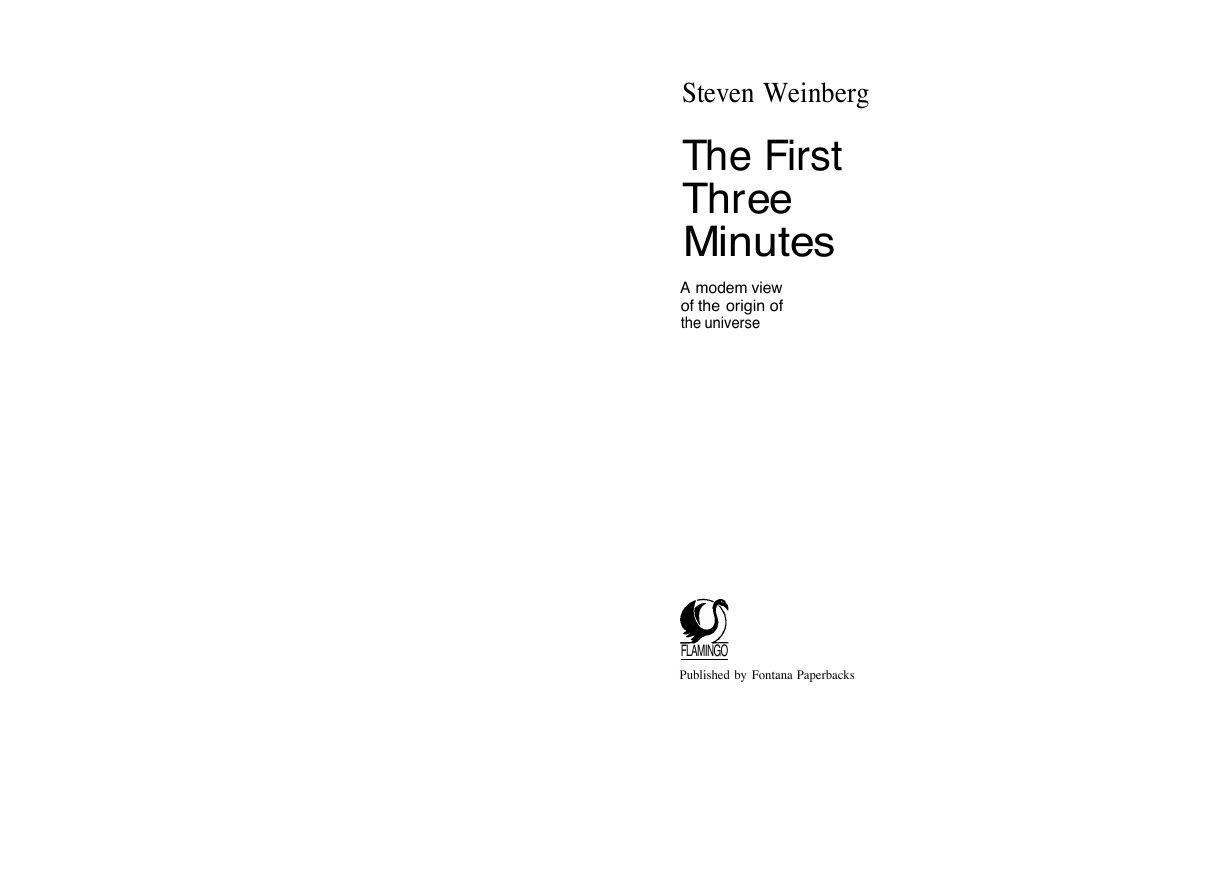
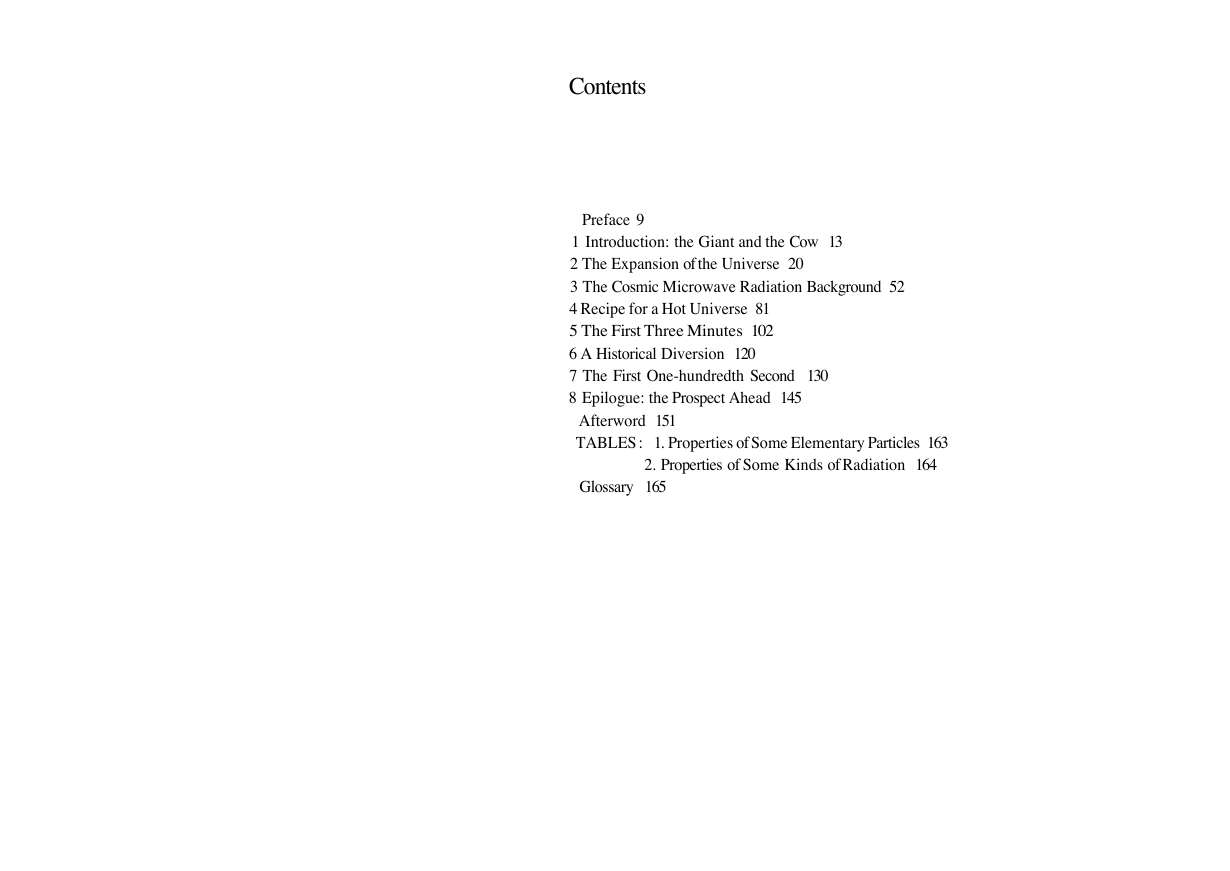

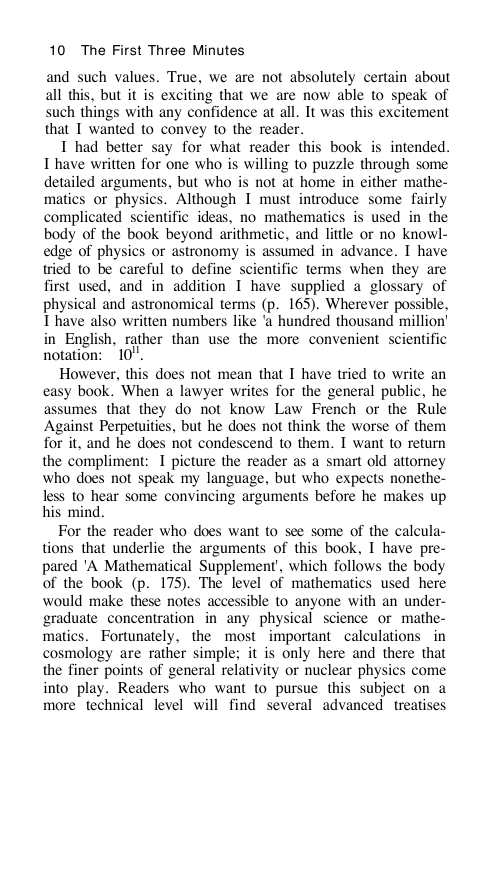
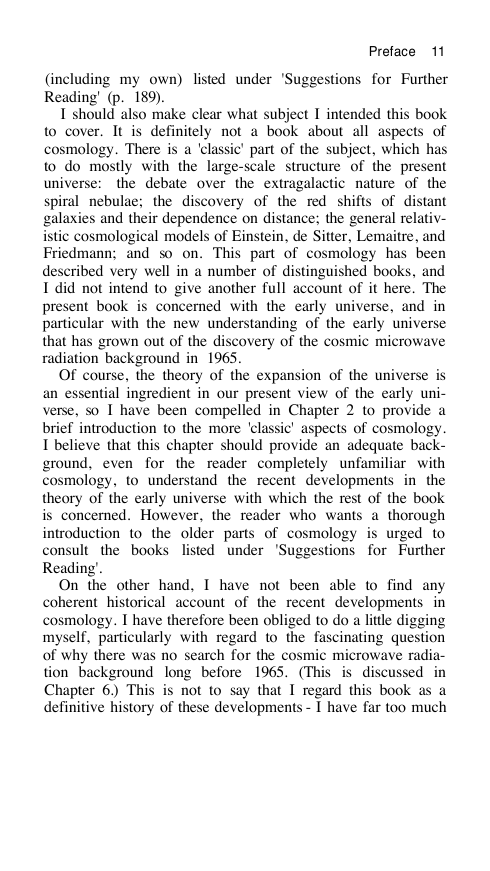
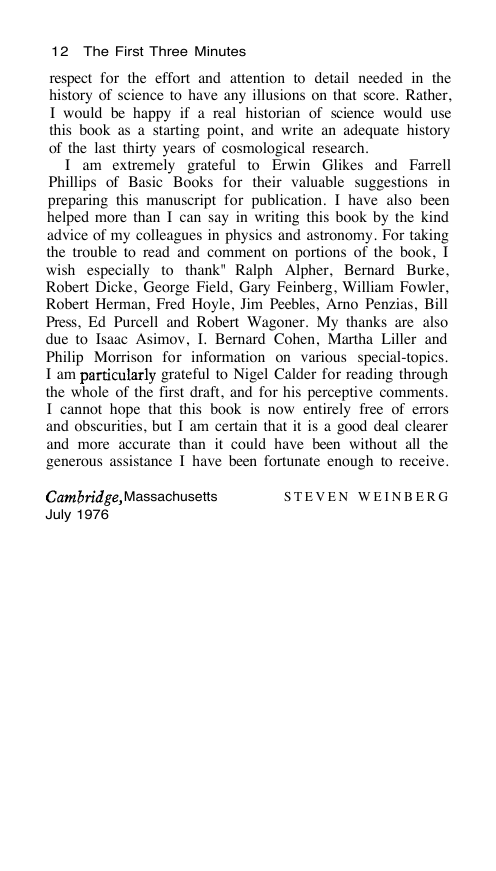
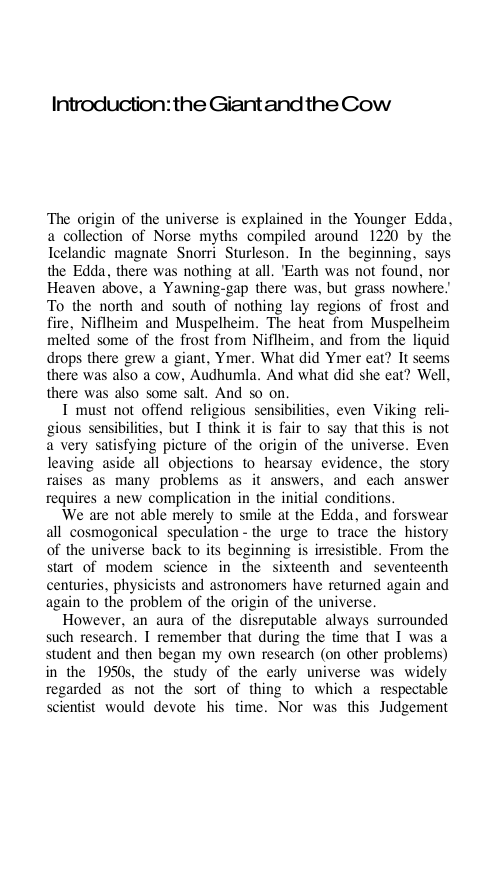
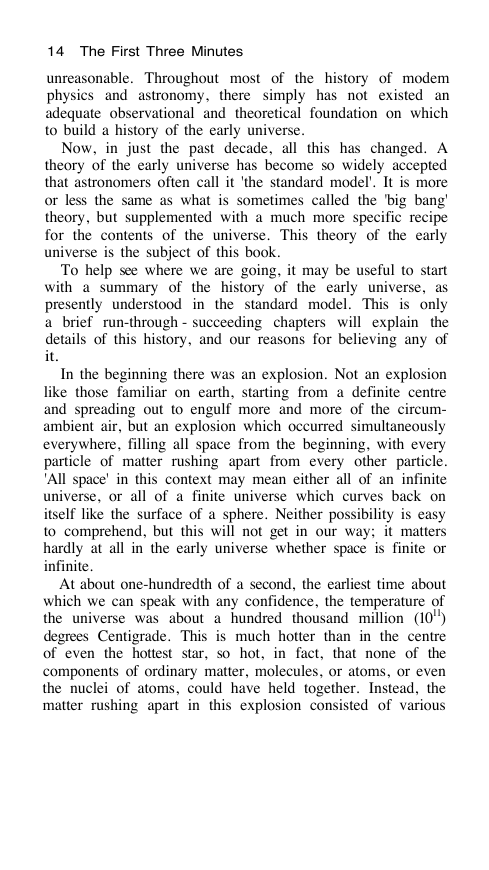








 2023年江西萍乡中考道德与法治真题及答案.doc
2023年江西萍乡中考道德与法治真题及答案.doc 2012年重庆南川中考生物真题及答案.doc
2012年重庆南川中考生物真题及答案.doc 2013年江西师范大学地理学综合及文艺理论基础考研真题.doc
2013年江西师范大学地理学综合及文艺理论基础考研真题.doc 2020年四川甘孜小升初语文真题及答案I卷.doc
2020年四川甘孜小升初语文真题及答案I卷.doc 2020年注册岩土工程师专业基础考试真题及答案.doc
2020年注册岩土工程师专业基础考试真题及答案.doc 2023-2024学年福建省厦门市九年级上学期数学月考试题及答案.doc
2023-2024学年福建省厦门市九年级上学期数学月考试题及答案.doc 2021-2022学年辽宁省沈阳市大东区九年级上学期语文期末试题及答案.doc
2021-2022学年辽宁省沈阳市大东区九年级上学期语文期末试题及答案.doc 2022-2023学年北京东城区初三第一学期物理期末试卷及答案.doc
2022-2023学年北京东城区初三第一学期物理期末试卷及答案.doc 2018上半年江西教师资格初中地理学科知识与教学能力真题及答案.doc
2018上半年江西教师资格初中地理学科知识与教学能力真题及答案.doc 2012年河北国家公务员申论考试真题及答案-省级.doc
2012年河北国家公务员申论考试真题及答案-省级.doc 2020-2021学年江苏省扬州市江都区邵樊片九年级上学期数学第一次质量检测试题及答案.doc
2020-2021学年江苏省扬州市江都区邵樊片九年级上学期数学第一次质量检测试题及答案.doc 2022下半年黑龙江教师资格证中学综合素质真题及答案.doc
2022下半年黑龙江教师资格证中学综合素质真题及答案.doc